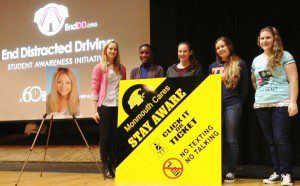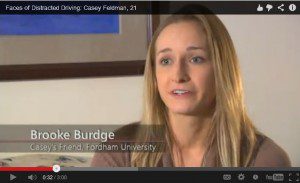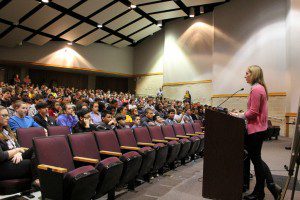The following is a guest blog by Brooke Burdge, a friend of Casey’s during her time at Fordham University.

On March 11, I had the opportunity to speak with close to 1,000 students and faculty at Monmouth Regional High School in Tinton Falls, New Jersey on the topic of distracted driving. My presentation was part of the EndDD.org End Distracted Driving Student Awareness Initiative, which since its inception in 2012, has reached over 60,000 high school students.
At the start of my presentation, I gave a brief overview of EndDD’s mission, as well as some background on the inspiration for these presentations. I described how in the summer of 2009, an attorney and father named Joel Feldman from Pennsylvania got the news that his 21-year-old daughter, Casey, was struck and killed by a distracted driver while she was a pedestrian in a crosswalk on her way to her summer job in Ocean City, New Jersey. I told them how he then established the Casey Feldman Foundation in memory of his daughter and created EndDD.org and the distracted driving presentation to educate others about the dangers of distracted driving.
Then, I let the group know a little more about me. Like them, I grew up in Monmouth County, NJ. After graduating from a nearby high school in 2006, I went on to Fordham University, where I made a great friend named Casey. This is the moment where I showed them a slide with photos of Casey and myself throughout our time together, as well as two Facebook wall posts from Casey. In this moment, the audience realized my direct connection to this cause and the root of my passion for this issue.

Later in the presentation, I showed the students the “Faces of Distracted Driving” video created for the U.S. Department of Transportation, in which a few of Casey’s friends and I talk about the preventable nature of Casey’s tragedy. I explained to the students that you tend to see these types of videos and think, “Something like this couldn’t happen to me or my friends,” but those are all my good friends on that screen, and it’s very real to each of us.
Throughout the presentation, I reminded the group of three main points. First, this is not just a teen problem. Adults are also guilty. I shared that before July 2009, I was also guilty of distracted driving. Secondly, I let them know that this is a choice. I wasn’t there to tell them what they should or should not be doing. I was there to give them information, and share a few stories, that they can take into consideration when making their own choices behind the wheel. And third, I reminded that that yes, these stories are sad, but they’re preventable. I wanted them to understand that although what happened to Casey and others they would hear about is extremely upsetting, it didn’t have to happen. I wanted everyone in the room to walk away feeling like they were in a position to help stop future tragedies like these from taking place.

Before the presentation, over 400 students had completed questionnaires about distracted driving. I covered the forms of distracted driving they had mentioned most frequently in their surveys—taking eyes off the road, texting, talking on the phone. But, I also wanted them to think more about the other kinds of distracted driving that may not come to mind as frequently, but are just as dangerous, such as eating, changing music, applying makeup, programming a GPS, and reaching for something.
We discussed the importance of speaking up for your own safety when a passenger in an adult’s or a friend’s car—how you can offer to take your driver’s phone and cover any calls or texts for them while they are driving. Through various stories about the numerous consequences of distracted driving, I hoped to drive home the point that this is sad, but preventable. Just a few seconds can change everything, and in the end, are those few seconds of distraction really worth the consequences?
I want to thank those faculty and students who helped organize this assembly. Additionally, I want to thank every student and faculty member in that room for their attention. A handful of students have reached out to me on social media since the assembly, and I am so happy that this presentation helped them think about distracted driving in a new light.
NOTE: View photos from the presentation here. View Brooke Burdge and Casey’s other friends in the Faces of Distracted Driving video below speaking about Casey and how they changed they driving habits after Casey’s death. View U.S. Secretary of Transportation, Ray LaHood’s blog article introducing the video.




